2008 Seat Ibiza 5D tyre pressure
[x] Cancel search: tyre pressurePage 206 of 260
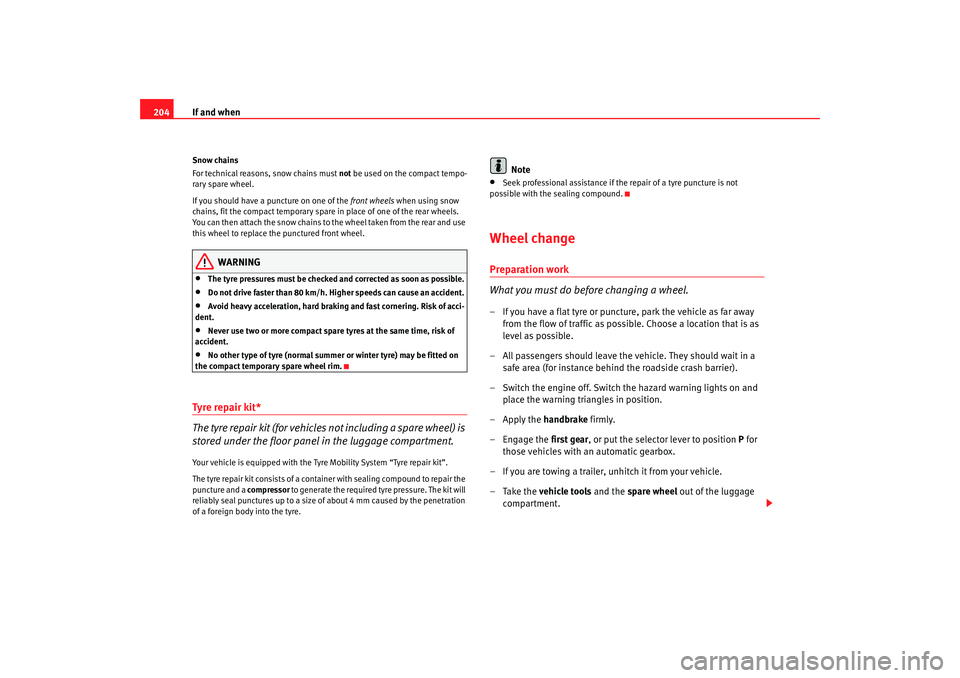
If and when
204Snow chains
For technical reasons, snow chains must not be used on the compact tempo-
rary spare wheel.
If you should have a puncture on one of the front wheels when using snow
chains, fit the compact temporary spare in place of one of the rear wheels.
You can then attach the snow chains to the wheel taken from the rear and use
this wheel to replace the punctured front wheel.
WARNING
•
The tyre pressures must be checked and corrected as soon as possible.
•
Do not drive faster than 80 km/h. Hi gher speeds can cause an accident.
•
Avoid heavy acceleration, hard braking and fast cornering. Risk of acci-
dent.
•
Never use two or more compact spare tyres at the same time, risk of
accident.
•
No other type of tyre (normal summer or winter tyre) may be fitted on
the compact temporary spare wheel rim.
Tyre repair kit*
The tyre repair kit (for vehicles not including a spare wheel) is
stored under the floor panel in the luggage compartment.Your vehicle is equipped with the Tyre Mobility System “Tyre repair kit”.
The tyre repair kit consists of a container with sealing compound to repair the
puncture and a compressor to generate the required tyre pressure. The kit will
reliably seal punctures up to a size of about 4 mm caused by the penetration
of a foreign body into the tyre.
Note
•
Seek professional assistance if the repair of a tyre puncture is not
possible with the sealing compound.
Wheel changePreparation work
What you must do before changing a wheel.– If you have a flat tyre or puncture, park the vehicle as far away from the flow of traffic as possible. Choose a location that is as
level as possible.
– All passengers should leave the vehicle. They should wait in a
safe area (for instance behind the roadside crash barrier).
– Switch the engine off. Switch the hazard warning lights on and place the warning triangles in position.
–Apply the handbrake firmly.
– Engage the first gear, or put the selector lever to position P for
those vehicles with an automatic gearbox.
– If you are towing a trailer, unhitch it from your vehicle.
–Take the vehicle tools and the spare wheel out of the luggage
compartment.
Ibiza250_angles Seite 204 Dienstag, 5. August 2008 1:11 13
Page 207 of 260

If and when205
Safety First
Operating instructions
Practical tips
Te c h n i c a l D a t a
WARNING
Switch on the hazard warning lights on and place the warning triangles in
position. This is for your own safety and also warns other road users.
Caution
If you have to change the wheel on a s lope, it is essential to lock the wheel
parallel and on the same axle as that to be changed, with a wedge or similar
in order to immobilise the vehicle.
Note
Please observe legal requirements when doing so.Changing a wheelChange the wheel as described below
– Remove the hub caps or the integral trim .
– Slacken the wheel bolts.
– Raise the car with the jack in the corresponding zone.
– Remove the wheel and then put on the spare wheel.
– Lower the vehicle.
– Tighten the wheel bolts firmly with the box spanner.
–Replace the hub cap.
After changing a wheel
After changing the wheel there are still tasks to complete.– Put the tools and jack back in the luggage compartment.
– Place the wheel with the defective tyre in the luggage compart-
ment and secure it.
– Check the tyre pressure of the newly fitted tyre as soon as
possible.
– Have the tightening torque of the wheel bolts checked as soon as possible with a torque wrench. The prescribed torque must be
120 Nm.
Note•
If you notice that the wheel bolts are corroded and difficult to turn when
changing a wheel, they must be replaced before having the wheel bolt torque
checked.
•
For your safety, drive at moderate speeds until the wheel bolt torque has
been checked.
Ibiza250_angles Seite 205 Dienstag, 5. August 2008 1:11 13
Page 213 of 260

If and when211
Safety First
Operating instructions
Practical tips
Te c h n i c a l D a t a
Tyre repair
The following sections describe the procedures for repairing
a tyre.Using the sealing compound
– The instructions on the container give detailed information on
how to use the sealing compound.
Inflating the tyre.
– Remove the air compressor and hose from the container.
– Screw the retaining nut onto the valve.
– Plug the compressor cable into a 12 volt power point.
– Turn on compressor and monitor the pressure shown on the pres- sure gauge.
Completing the repair
– Remove the compressor hose from the valve.
– Fit the valve cap.
– Unplug the compressor from the socket.
– Return all tools to their proper storing location.
NoteThe compressor should never be allowed to run for longer than 6 minutes.
FusesChanging a fuse
Blown fuses must be replacedFuse cover
– Switch off the ignition and its failed electrical component.
– Identify the fuse corresponding to the damaged electric consumer ⇒page 213.
– Take the plastic clip from inside the fuse cover, fit it onto the
blown fuse and pull the fuse out.
– Replace the blown fuse (which will have a melted metal strip) with a new fuse of the same ampere rating.
Fig. 141 Fuses in the
dash panel
Ibiza250_angles Seite 211 Dienstag, 5. August 2008 1:11 13
Page 238 of 260
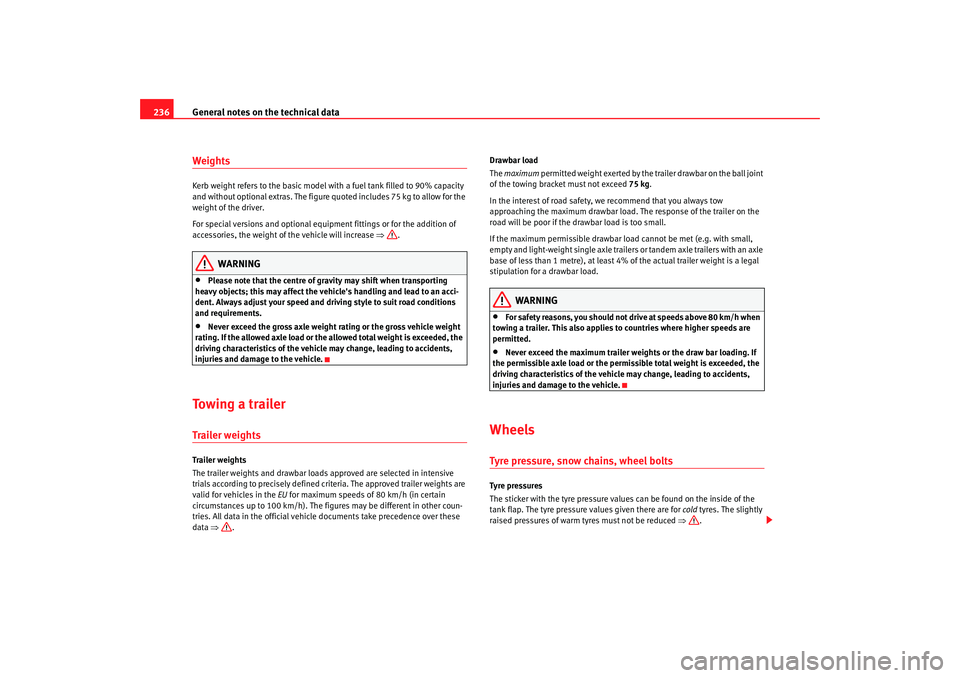
General notes on the technical data
236WeightsKerb weight refers to the basic model with a fuel tank filled to 90% capacity
and without optional extras. The figure quoted includes 75 kg to allow for the
weight of the driver.
For special versions and optional equipment fittings or for the addition of
accessories, the weight of the vehicle will increase ⇒.
WARNING
•
Please note that the centre of gravity may shift when transporting
heavy objects; this may affect the vehi cle's handling and lead to an acci-
dent. Always adjust your speed and dr iving style to suit road conditions
and requirements.
•
Never exceed the gross axle weight rating or the gross vehicle weight
rating. If the allowed axle load or the allowed total weight is exceeded, the
driving characteristics of the vehicle may change, leading to accidents,
injuries and damage to the vehicle.
To w i n g a t r a i l e rTrailer weightsTrailer weights
The trailer weights and drawbar loads approved are selected in intensive
trials according to precisely defined criteria. The approved trailer weights are
valid for vehicles in the EU for maximum speeds of 80 km/h (in certain
circumstances up to 100 km/h). The figu res may be different in other coun-
tries. All data in the official vehicl e documents take precedence over these
data ⇒ . Drawbar load
The
maximum permitted weight exerted by the trailer drawbar on the ball joint
of the towing bracket must not exceed 75 kg.
In the interest of road safety, we recommend that you always tow
approaching the maximum drawbar load. The response of the trailer on the
road will be poor if th e drawbar load is too small.
If the maximum permissible drawbar load cannot be met (e.g. with small,
empty and light-weight single axle trailers or tandem axle trailers with an axle
base of less than 1 metre), at least 4% of the actual trailer weight is a legal
stipulation for a drawbar load.
WARNING
•
For safety reasons, you should not drive at speeds above 80 km/h when
towing a trailer. This also applies to countries where higher speeds are
permitted.
•
Never exceed the maximum trailer weights or the draw bar loading. If
the permissible axle load or the perm issible total weight is exceeded, the
driving characteristics of the vehicle may change, leading to accidents,
injuries and damage to the vehicle.
WheelsTyre pressure, snow chains, wheel boltsTyre pressures
The sticker with the tyre pressure values can be found on the inside of the
tank flap. The tyre pressure values given there are for cold tyres. The slightly
raised pressures of warm tyres must not be reduced ⇒.
Ibiza250_angles Seite 236 Dienstag, 5. August 2008 1:11 13
Page 239 of 260
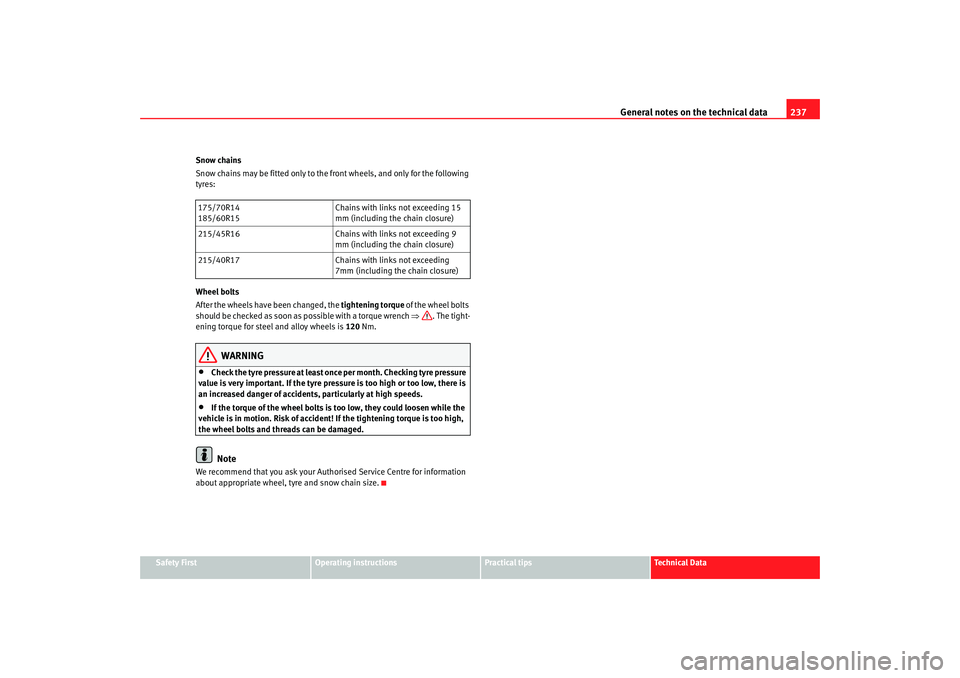
General notes on the technical data 237
Safety First
Operating instructions
Practical tips
Te c h n i c a l D a t a
Snow chains
Snow chains may be fitted only to the front wheels, and only for the following
tyres:
Wheel bolts
After the wheels have been changed, the
tightening torque of the wheel bolts
should be checked as soon as possible with a torque wrench ⇒. The tight-
ening torque for steel and alloy wheels is 120 Nm.
WARNING
•
Check the tyre pressure at least once per month. Checking tyre pressure
value is very important. If the tyre pre ssure is too high or too low, there is
an increased danger of accidents, particularly at high speeds.
•
If the torque of the wheel bolts is to o low, they could loosen while the
vehicle is in motion. Risk of accident! If the tightening torque is too high,
the wheel bolts and threads can be damaged.Note
We recommend that you ask your Authorised Service Centre for information
about appropriate wheel, tyre and snow chain size. 175/70R14
185/60R15
Chains with links not exceeding 15
mm (including the chain closure)
215/45R16 Chains with links not exceeding 9
mm (including the chain closure)
215/40R17 Chains with links not exceeding
7mm (including the chain closure)
Ibiza250_angles Seite 237 Dienstag, 5. August 2008 1:11 13
Page 249 of 260
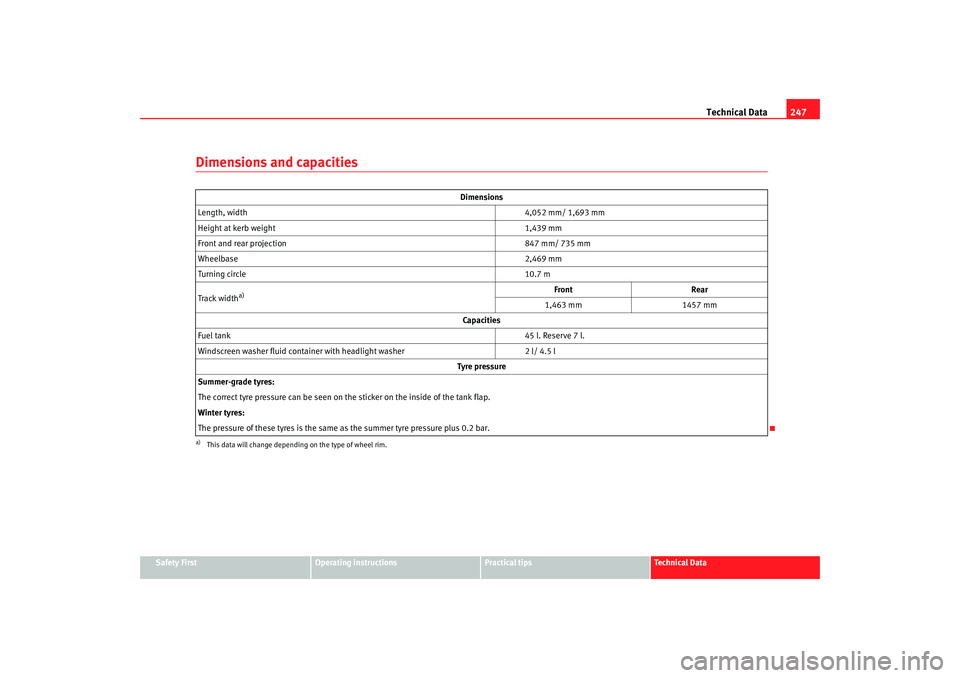
Technical Data247
Safety First
Operating instructions
Practical tips
Te c h n i c a l D a t a
Dimensions and capacities
Dimensions
Length, width 4,052 mm/ 1,693 mm
Height at kerb weight 1,439 mm
Front and rear projection 847 mm/ 735 mm
Wheelbase 2,469 mm
Turning circle 10.7 m
Track width
a)
a)This data will change depending on the type of wheel rim.
Front Rear
1,463 mm 1457 mm
Capacities
Fuel tank 45 l. Reserve 7 l.
Windscreen washer fluid container with headlight washer 2 l/ 4.5 l
Tyre pressure
Summer-grade tyres:
The correct tyre pressure can be seen on the sticker on the inside of the tank flap.
Winter tyres:
The pressure of these tyres is the same as the summer tyre pressure plus 0.2 bar.
Ibiza250_angles Seite 247 Dienstag, 5. August 2008 1:11 13
Page 257 of 260
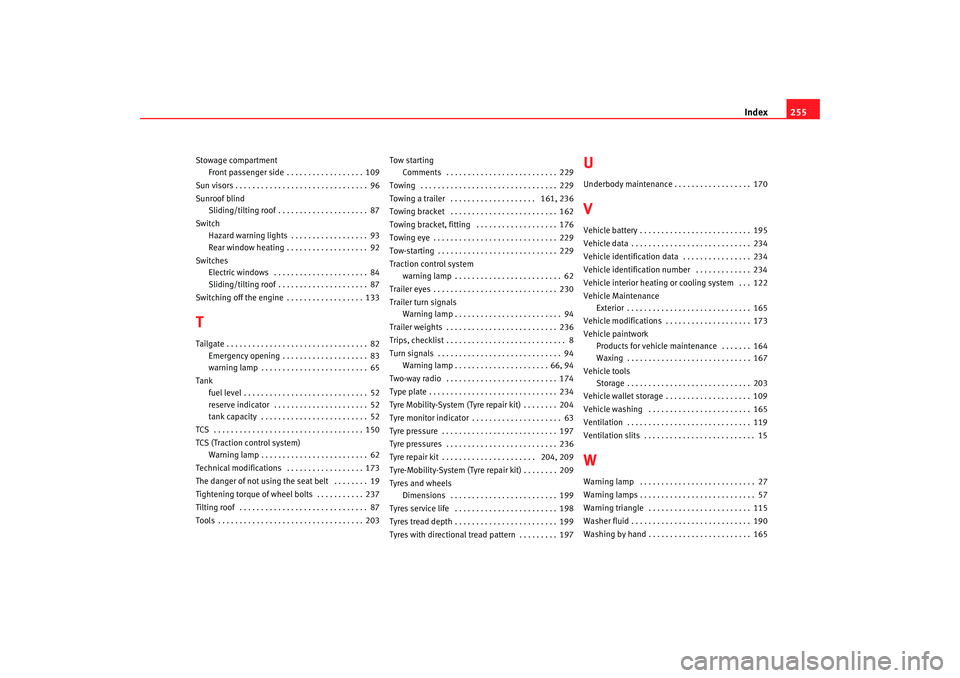
Index255
Stowage compartment
Front passenger side . . . . . . . . . . . . . . . . . . 109
Sun visors . . . . . . . . . . . . . . . . . . . . . . . . . . . . . . . 96
Sunroof blind Sliding/tilting roof . . . . . . . . . . . . . . . . . . . . . 87
Switch Hazard warning lights . . . . . . . . . . . . . . . . . . 93
Rear window heating . . . . . . . . . . . . . . . . . . . 92
Switches Electric windows . . . . . . . . . . . . . . . . . . . . . . 84
Sliding/tilting roof . . . . . . . . . . . . . . . . . . . . . 87
Switching off the engine . . . . . . . . . . . . . . . . . . 133TTailgate . . . . . . . . . . . . . . . . . . . . . . . . . . . . . . . . . 82 Emergency opening . . . . . . . . . . . . . . . . . . . . 83
warning lamp . . . . . . . . . . . . . . . . . . . . . . . . . 65
Tank fuel level . . . . . . . . . . . . . . . . . . . . . . . . . . . . . 52
reserve indicator . . . . . . . . . . . . . . . . . . . . . . 52
tank capacity . . . . . . . . . . . . . . . . . . . . . . . . . 52
TCS . . . . . . . . . . . . . . . . . . . . . . . . . . . . . . . . . . . 150
TCS (Traction control system) Warning lamp . . . . . . . . . . . . . . . . . . . . . . . . . 62
Technical modifications . . . . . . . . . . . . . . . . . . 173
The danger of not using the seat belt . . . . . . . . 19
Tightening torque of wheel bolts . . . . . . . . . . . 237
Tilting roof . . . . . . . . . . . . . . . . . . . . . . . . . . . . . . 87
Tools . . . . . . . . . . . . . . . . . . . . . . . . . . . . . . . . . . 203 Tow starting
Comments . . . . . . . . . . . . . . . . . . . . . . . . . . 229
Towing . . . . . . . . . . . . . . . . . . . . . . . . . . . . . . . . 229
Towing a trailer . . . . . . . . . . . . . . . . . . . . 161, 236
Towing bracket . . . . . . . . . . . . . . . . . . . . . . . . . 162
Towing bracket, fitting . . . . . . . . . . . . . . . . . . . 176
Towing eye . . . . . . . . . . . . . . . . . . . . . . . . . . . . . 229
Tow-starting . . . . . . . . . . . . . . . . . . . . . . . . . . . . 229
Traction control system warning lamp . . . . . . . . . . . . . . . . . . . . . . . . . 62
Trailer eyes . . . . . . . . . . . . . . . . . . . . . . . . . . . . . 230
Trailer turn signals Warning lamp . . . . . . . . . . . . . . . . . . . . . . . . . 94
Trailer weights . . . . . . . . . . . . . . . . . . . . . . . . . . 236
Trips, checklist . . . . . . . . . . . . . . . . . . . . . . . . . . . . 8
Turn signals . . . . . . . . . . . . . . . . . . . . . . . . . . . . . 94 Warning lamp . . . . . . . . . . . . . . . . . . . . . . 66, 94
Two-way radio . . . . . . . . . . . . . . . . . . . . . . . . . . 174
Type plate . . . . . . . . . . . . . . . . . . . . . . . . . . . . . . 234
Tyre Mobility-System (Tyre repair kit) . . . . . . . . 204
Tyre monitor indicator . . . . . . . . . . . . . . . . . . . . . 63
Tyre pressure . . . . . . . . . . . . . . . . . . . . . . . . . . . 197
Tyre pressures . . . . . . . . . . . . . . . . . . . . . . . . . . 236
Tyre repair kit . . . . . . . . . . . . . . . . . . . . . . 204, 209
Tyre-Mobility-System (Tyre repair kit) . . . . . . . . 209
Tyres and wheels Dimensions . . . . . . . . . . . . . . . . . . . . . . . . . 199
Tyres service life . . . . . . . . . . . . . . . . . . . . . . . . 198
Tyres tread depth . . . . . . . . . . . . . . . . . . . . . . . . 199
Tyres with directional tread pattern . . . . . . . . . 197
UUnderbody maintenance . . . . . . . . . . . . . . . . . . 170VVehicle battery . . . . . . . . . . . . . . . . . . . . . . . . . . 195
Vehicle data . . . . . . . . . . . . . . . . . . . . . . . . . . . . 234
Vehicle identification data . . . . . . . . . . . . . . . . 234
Vehicle identification number . . . . . . . . . . . . . 234
Vehicle interior heating or cooling system . . . 122
Vehicle Maintenance Exterior . . . . . . . . . . . . . . . . . . . . . . . . . . . . . 165
Vehicle modifications . . . . . . . . . . . . . . . . . . . . 173
Vehicle paintwork Products for vehicle maintenance . . . . . . . 164
Waxing . . . . . . . . . . . . . . . . . . . . . . . . . . . . . 167
Vehicle tools Storage . . . . . . . . . . . . . . . . . . . . . . . . . . . . . 203
Vehicle wallet storage . . . . . . . . . . . . . . . . . . . . 109
Vehicle washing . . . . . . . . . . . . . . . . . . . . . . . . 165
Ventilation . . . . . . . . . . . . . . . . . . . . . . . . . . . . . 119
Ventilation slits . . . . . . . . . . . . . . . . . . . . . . . . . . 15WWarning lamp . . . . . . . . . . . . . . . . . . . . . . . . . . . 27
Warning lamps . . . . . . . . . . . . . . . . . . . . . . . . . . . 57
Warning triangle . . . . . . . . . . . . . . . . . . . . . . . . 115
Washer fluid . . . . . . . . . . . . . . . . . . . . . . . . . . . . 190
Washing by hand . . . . . . . . . . . . . . . . . . . . . . . . 165
Ibiza250_angles Seite 255 Dienstag, 5. August 2008 1:11 13
Page 258 of 260
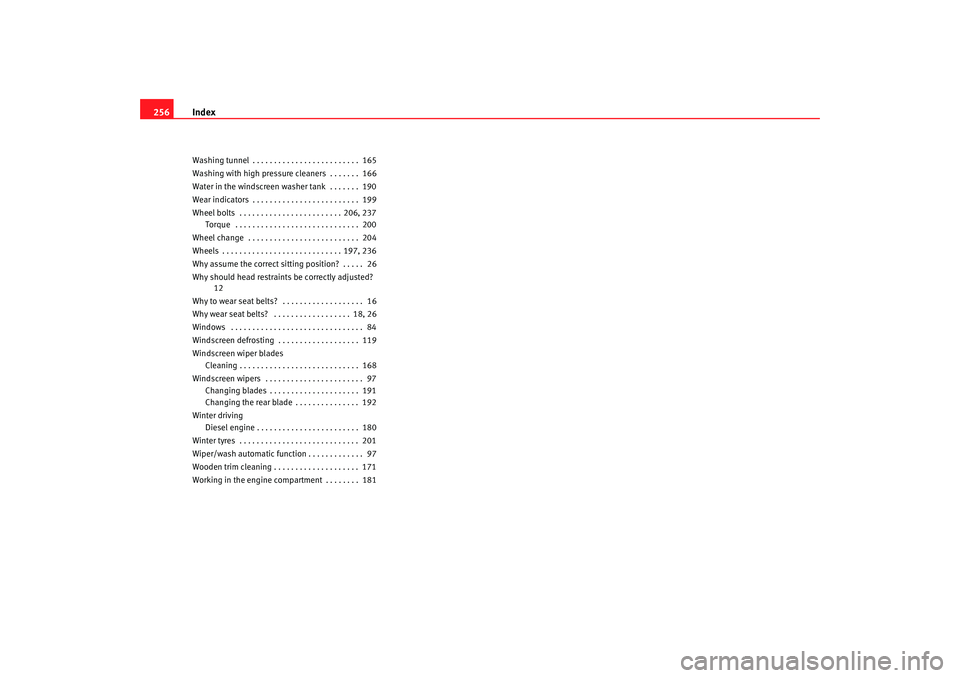
Index
256Washing tunnel . . . . . . . . . . . . . . . . . . . . . . . . . 165
Washing with high pressure cleaners . . . . . . . 166
Water in the windscreen washer tank . . . . . . . 190
Wear indicators . . . . . . . . . . . . . . . . . . . . . . . . . 199
Wheel bolts . . . . . . . . . . . . . . . . . . . . . . . . 206, 237 Torque . . . . . . . . . . . . . . . . . . . . . . . . . . . . . 200
Wheel change . . . . . . . . . . . . . . . . . . . . . . . . . . 204
Wheels . . . . . . . . . . . . . . . . . . . . . . . . . . . . 197, 236
Why assume the correct sitting position? . . . . . 26
Why should head restraints be correctly adjusted?
12
Why to wear seat belts? . . . . . . . . . . . . . . . . . . . 16
Why wear seat belts? . . . . . . . . . . . . . . . . . . 18, 26
Windows . . . . . . . . . . . . . . . . . . . . . . . . . . . . . . . 84
Windscreen defrosting . . . . . . . . . . . . . . . . . . . 119
Windscreen wiper blades Cleaning . . . . . . . . . . . . . . . . . . . . . . . . . . . . 168
Windscreen wipers . . . . . . . . . . . . . . . . . . . . . . . 97 Changing blades . . . . . . . . . . . . . . . . . . . . . 191
Changing the rear blade . . . . . . . . . . . . . . . 192
Winter driving Diesel engine . . . . . . . . . . . . . . . . . . . . . . . . 180
Winter tyres . . . . . . . . . . . . . . . . . . . . . . . . . . . . 201
Wiper/wash automatic function . . . . . . . . . . . . . 97
Wooden trim cleaning . . . . . . . . . . . . . . . . . . . . 171
Working in the engine compartment . . . . . . . . 181
Ibiza250_angles Seite 256 Dienstag, 5. August 2008 1:11 13